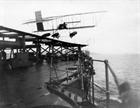On this day 2 May 1912
On this day 2 May 1912, First launch of an aircraft from a ship under way.
Improved S27 No 38 was one of four naval aircraft to take part in the 1912 Fleet Review at Weymouth, the others being a Short S.41 tractor biplane, a Deperdussin monoplane and a Nieuport monoplane. It was flown by Commander Samson and Lieutenant Gregory. A display of the possibilities of naval aviation was made in the presence of King George V, including a demonstration of the use of aircraft for spotting submerged submarines and the dropping of a 300 lb (140 kg) dummy bomb by Gregory.
The Times, reported on 9 May 1912. The second day of the review, Naval aviator Lt Charles Rumney Samson made history with the first take off of an aircraft from a moving ship. The aircraft involved was an Improved Short S27 No38 'amphibian', a pusher biplane carrying the serial number T2 and fitted with a 70 hp Gnome engine, and one of two such aircraft belonging to the Naval Flying School at Eastchurch in Kent. The ship was the battleship HMS Hibernia under the command of Captain Grafton which, like HMS Africa, was a 12" gun battleship of the King Edward VII class which had been modified, using a ramp mounted to its gun turrets. When the warship was some three miles off the Portland Harbour breakwaters, and steaming at just over 10 knots, Lt Samson was launched over the warship's bows from a wooden platform on the foredeck. The aircraft rose after 45ft and flew over the breakwaters and across Weymouth Bay to land at the conclusion of his flight at the eastern end of Lodmoor, adjacent to where the town's local racecourse was once located. Afterwards the ramp was transferred to the battleship HMS London, and Samson repeated the feat on 4 July 1912 taking 25 ft to take off whilst the ship was steaming at 12 knots into wind.
Link to Report in Flight magazine dated 18 May 1912
Samson took part in various early naval aviation experiments, including the development of navigation lights and bomb sights. He was keen to embrace the technology of the day and also commanded the first British armoured vehicles used in combat.




